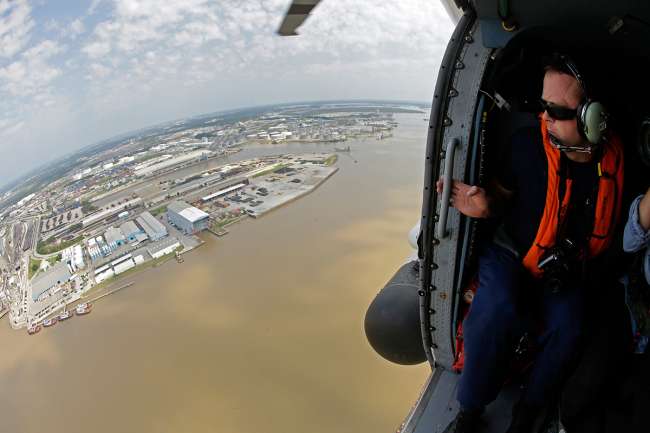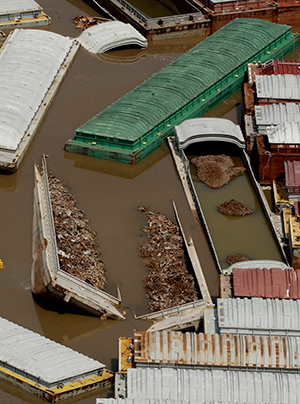Staff Reporter
Carriers Face Congestion, Rerouting After Harvey Devastates Texas

Ports across Texas have gradually resumed operations and inundated highways are beginning to clear, but the intermodal chain still faces challenges in Hurricane Harvey’s wake.
Freight carriers are adjusting routes and facing heavy congestion due to such obstacles as flooded roadways and a shortage of drivers left by record-breaking rainfall from the storm.
HARROWING HARVEY: Trucker caught in floodwaters recalls the experience.
After closing to brace for the powerful hurricane, ports at Corpus Christi, Galveston and Houston returned to normal operations as of Sept. 5.
The Texas Department of Transportation announced Sept. 5 that Interstate 10, Houston’s major east-west freight route, had reopened. However, TxDOT said segments of State Highways 6 and 8, which intersect with I-10, still are closed.
The region’s other major highways, interstates 45, 69 and 610, are open, according to TxDOT.
Roads in Texas may be flooded from #Harvey. Before venturing out, check https://t.co/qpebGTn2XY for road closures/conditions! #txwx @TxDOT pic.twitter.com/8j1swM0Nub — TDHCA (@TDHCA) August 29, 2017
Pamela Dotson, operations manager at W.W. Rowland Trucking Co. Inc.’s Houston office, said local runs on I-10 that would normally take 45 minutes are now taking about 1.5 hours.
“It’s open, but the traffic is still heavy because other freeways are closed,” Dotson said. “The roadway was OK getting to the port and to the railroad. It’s just getting to our customers that we had issues with.”
Marcia Faschingbauer, president of Houston-based trucking company Excargo, said her drivers have been using alternate routes to avoid the congestion on I-10. She also said the company, which was fully operational Aug. 31 and stayed open on Labor Day, had to pick up freight in Dallas because it could not reach its operations in Houston.

Deluged barges Sept. 1 at the Port of Houston in the wake of Hurricane Harvey. (Charlie Riedel/Associated Press)
Faschingbauer said she and her team urged their customers to keep their original plans, rather than reroute shipments to other terminals, because Port of Houston recovery efforts were underway soon after the storm hit. The Port of Houston reopened Sept. 1.
“We encouraged our customers to keep bookings at Port of Houston because we knew they’d be open soon,” Faschingbauer said. “We had our global customers reach out to us and say they were going to start diverting to other ports. The majority of those plans actually were abandoned because there was no need.”
Other companies’ shipments were diverted because vessels could not enter the Port of Houston. For example, Container Port Group, an intermodal services company, had shipments diverted from its Houston destination to New Orleans and Mobile, Ala. The company, which has locations across the country, has an outpost within a 5-mile radius of the Port of Houston’s Bayport and Barbours Cut terminals.
Container Port has notified its customers that their shipments have been rolled to later vessel schedules, a spokesman said.
We encouraged our customers to keep bookings at Port of Houston because we knew they’d be open soon.
Excargo President Marcia Faschingbauer
“One of our biggest challenges is that steamship lines diverted vessels scheduled to call at Port Houston, and we have cargo arriving in other locations that was supposed to discharge in Houston,” the spokesman said. “We have the ability to send trucks from our Houston terminal to recover some of these loads, but the customers are not making these arrangements as the steamship lines who diverted the cargo are bringing them to their original destination through their network of regional and national carriers.”
W.W. Rowland also has been alerting customers to delays. Dotson said some of their customers have been more patient than others. She said one customer in Colorado hired a truck to drive from Colorado to Houston and pick up his shipment because he did not want a delay.
An Anheuser Busch Cos. spokeswoman said that a number of the company’s containers were delayed in the Gulf as of Sept. 1, but that the company’s stranded containers were expected to reach their destinations by Sept. 7.
According to Datamyne, Anheuser Busch was one of Houston’s leading imports in 2016. One of the company’s 12 breweries is located in Houston.

Esparza
John Esparza, president of the Texas Trucking Association, said he spoke with several carriers whose drivers could not make deliveries because they were trapped at their flooded homes. But, he said, driver movement and road conditions have improved immensely since the Category 4 hurricane hit eastern Texas and deluged it with a record 52 inches of rain.
Excargo’s Faschingbauer said organizations related to freight transportation have been communicating frequently during and after the hurricane.
“I’m a native. I’ve been through many storms,” Faschingbauer said. “This was the worst, but it was the best in terms of responsiveness and communication and cohesion.”
The Port of Galveston opened Sept. 1 with restrictions on vessels with more than a 33-foot draft, said interim port director Peter Simons, referring to how shallow water can be for a ship to safely traverse it.
Cristina Galego, a spokeswoman for the Port of Galveston, said the port lifted draft limitations on Sept. 4.
Galveston processes roll-on, roll-off cargo such as farm equipment, cars and fire trucks going overseas. It also receives weekly shipments of Del Monte fruit from Guatemala, he said.
The Port of Corpus Christi’s leading commodities include crude, gasoline and diesel, according to the port’s website. Eddie Martinez, business development representative for the port, said the “petroleum port” also handles wind turbines and grain.

